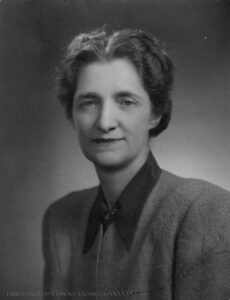“People who don’t want a woman architect just don’t come to you. But others see the advantage of your being able to interpret their individual needs because you are a woman.”
The Sunday Star, March 25, 1956
Dedication to Details
Gertrude Sawyer wanted to be an architect from a young age. She obtained her landscape architecture degree from the University of Illinois and was one of the first women to attend the Cambridge School. Women who attended the school created a network and collaborated on later projects. Fellow student Rose Greely was one of the women Sawyer worked with later in her career. Once her education was completed, she worked most notably for Horace Peaslee.
Sawyer was known as a pioneer woman architect who paid great attention to detail. This is evident in her work at the Jefferson Patterson Estate beginning in 1932. She is most noted for her Colonial Revival designs. Although she was working in the male-dominated field of architecture, Sawyer expressed that she “was always treated fairly.” Matilda McQuaid simply put it: “She did not work harder because she was a woman, but because she was a good architect.”
Sawyer’s dedication to architecture is what brought her lasting clients like Jefferson Patterson and contracts with the government. She gained her license to practice architecture in five different jurisdictions.
Work at Jefferson Patterson Estate
In 1932 Sawyer was hired to design the buildings at Point Farm, where she established great ties with the family. She ended up designing 26 building on the property and was dubbed the “family’s architect.” She had a knack for detail which is obvious in her sections and rigorous note taking.
Lieutenant Commander Gertrude Sawyer
Sawyer played an active role in the military from 1943 to 1945 as Lieutenant Commander for the Navy’s Civil Engineer Corps also known as the Seabees. During her service she and Lt. Kathleen F. Lux designed housing to satisfy the needs of 14,000 people. Their employer, the Office of The Potomac River Naval Command, sought out women architects for their ability to understand the needs of the home. After the war she served as the only female reserve Seabee officer.
